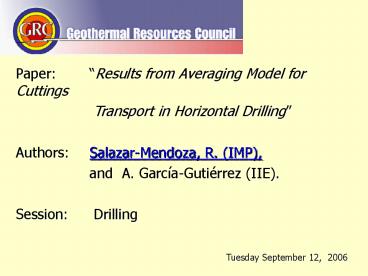Sin t PowerPoint PPT Presentation
1 / 27
Title: Sin t
1
Paper Results from Averaging Model for
Cuttings Transport in Horizontal
Drilling Authors Salazar-Mendoza, R. (IMP),
and A. García-Gutiérrez (IIE). Session
Drilling Tuesday September 12, 2006
2
- Table of Contents
- Introduction
- Model Description
- Methodology
- Results
- Conclusions
Acknowledgements
3
- Introduction
4
- Introduction...
Factors affecting drill cuttings transport
The pressure gradient is considered the most
important parameter in a solid-liquid flow
- Velocity
- Drill Cuttings volume fractions
- Drill Cuttings Density
- Fluid Density
- Fluid Viscosity
5
- Introduction...
There are three main flow patterns for
solid-liquid flow (Doron and Barnea, 1996) 1)
Fully suspended flow 2) Flow with a moving bed
3) Flow with a stationary bed
Photographies from Iyoho (1980)
6
- Model Description
7
- Methodology
Point Equations Fully suspended flow
Point Equations Stationary Bed
The Method of Volume Averaging (Whitaker, 1999)
Porous Medium Averaging Model ?-region
Two-Fluid Averaging Model ?-region
Closures
Closures
Condition of Local Mechanical Equilibrium
Two-Regions Averaging Model Flow with a
stationary bed
Numerical Solution
Comparation with Exp. Data
One-equation Averaging Model ?-region
Stress in the boundary ?-?
Conclusions
8
- Point equations
Interfacial Boundary Condition
Initial Conditions
Boundary Conditions
Interfacial Jump Conditions
9
- The Method of Volume Averaging
-Superficial average
-Intrinsic average
-Volume fraction
-Relation
10
- The Method of Volume Averaging...
-Spatial averaging theorem and the general
transport theorem (Gray and Lee, 1977)
11
- Two-Fluid Averaging Model for w-region
12
- Closures
13
- Condition of Local Mechanical Equilibrium
This mean that the fully suspended flow can be
characterized by a single velocity
14
- One-Equation Averaging Model for w-region
where
15
- Porous Medium Averaging Model for ?-region
Derived by Ochoa-Tapia and Whitaker (1995)
16
- Closures
17
- Final Formulation of the Two-Regions Averaging
Model for Cutting Transport in Horizontal Drilling
18
- Numerical Solution
19
- Results
Case 1.-Fully suspended flow
Case 2.-Flow with a stationary bed
Case 3.-Flow with a moving bed
20
- Results Case 1
21
- Results Case 2
22
- Results Case 2
23
- Results Case 3
24
- Results for Cases 2 and 3
25
- Results for Cases 2 and 3
26
- Conclusions
- In this work, the process of cutting transport
for the three main flow patterns was analyzed 1)
fully suspended flow, 2) flow with a stationary
bed, and 3) flow with a moving bed. - The numerical results and their comparison with
experimental data and theoretical results show
that 1) the model for a fully suspended flow is
not adequate for simulating a flow with a moving
bed nor a flow with a stationary bed, 2) the
models for a flow with a stationary bed and a
flow with moving bed allow to obtain the
theoretical flow pattern transition, as a
function of total volume fraction, which depends
on the maximum packing at the bottom of the pipe,
3) the results for the dimensionless pressure
gradient, obtained for a flow with a stationary
bed and a flow with a moving bed, are in
agreement with experimental data and theoretical
results reported in the literature
27
- Acknowledgements
The authors wish to thank the financial support
provided by the Instituto Mexicano del Petróleo
(IMP), the Consejo Nacional de Ciencia y
Tecnología (CONACyT), and the Secretaría de
Educación Pública (SEP) of México.

